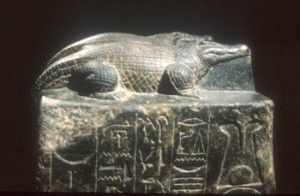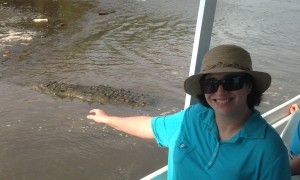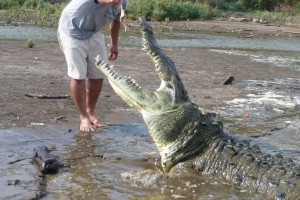The Haftarah and the Parsha share the theme of G-d’s influence on history. They also share a textual structure which can be analyzed to give us additional information about the message of both texts.
The Haftarah, in which Yehezekel warns Egypt of its impending defeat in the hands of Nevuchanezzar contains the following verses:
וְיָדְעוּ כִּי אֲנִי ה’ אֱ-לֹהֵיהֶם
26) and they will know that I am Hashem their G-d
וְיָדְעוּ כָּל יֹשְׁבֵי מִצְרַיִם כִּי אֲנִי ה’
6) And all the residents of Egypt will know that I am Hashem
וְיָדְעוּ כִּי אֲנִי ה’
9) and they will know that I am Hashem,
וְיָדְעוּ כִּי אֲנִי אֲ-דֹנָי ה’
16) and they will know that I am G-d, Hashem.
וְיָדְעוּ כִּי אֲנִי ה’
21) and they will know that I am Hashem.
There are five instances of the phrase “and they will know that I am Hashem” in a single chapter. The pronoun “they” in the first and the fifth instance refers to the Jewish People; in the middle three, it refers to Egypt.
The Parsha, which describes the plagues of Egypt, contains the following verses:
ו ז) וְלָקַחְתִּי אֶתְכֶם לִי לְעָם וְהָיִיתִי לָכֶם לֵא-לֹהִים וִידַעְתֶּם כִּי אֲנִי ה’ אֱ-לֹהֵיכֶם
(6:7) I will take you to be My people, and I will be your G-d, and you will know that I am Hashem your G-d….
ז ה) וְיָדְעוּ מִצְרַיִם כִּי אֲנִי ה’ בִּנְטֹתִי אֶת יָדִי עַל מִצְרָיִם
(7:5) Egypt will know that I am Hashem when I stretch out My arm over Egypt …
ז יז) בְּזֹאת תֵּדַע כִּי אֲנִי ה’:
(7:17) In this you will know that I am Hashem …
ח יח) לְמַעַן תֵּדַע כִּי אֲנִי ה’ בְּקֶרֶב הָאָרֶץ:
(8:18) … so that you will know that I am Hashem in the midst of the land.
ח’ יד) בַּעֲבוּר תֵּדַע כִּי אֵין כָּמֹנִי בְּכָל הָאָרֶץ:
(8:14) … so that you will know that there is no one like me in all the land.
י ב) וּלְמַעַן תְּסַפֵּר בְּאָזְנֵי בִנְךָ וּבֶן בִּנְךָ אֵת אֲשֶׁר הִתְעַלַּלְתִּי בְּמִצְרַיִם …וִידַעְתֶּם כִּי אֲנִי ה’:
(10:2) So that you shall tell your sons and grandsons what I did to Egypt … and you will know that I am Hashem.
Here there are six instances of the same phrase. The first and the last are addressed to the Jewish People and the middle four to Egypt. The first two are at the beginning of the Parsha, when G-d reviews the plan of Exodus with Moshe. They state the goal of the Exodus, which is two-fold: first, that Jewish People will come to know Hashem; second, that Egypt would. The middle three verses are stated during the plagues, once at the beginning of each triplet grouping[1]. In them, Moshe informs Pharaoh that the purpose of the upcoming plagues is that he, Pharaoh, should know Hashem. The final verse completes the pattern by repeating that the Jewish People should know Hashem.
Thus, both the Haftarah and the Parsha are structured so that the outer framework addresses the Jewish People, while the inner section, the main content, addresses Egypt. This tells us that while the goal of the Jewish People knowing Hashem is important, the Torah’s objective is that all the nations of the world know G-d, not only us.
Being that G-d made us His People and gave us the Torah, we sometimes think that we are His only concern. However, if G-d did not care whether or not Egypt knows Hashem, then neither Moshe nor Yechezkel would have been told to repeat it to them three times.
But what does it mean, to “know Hashem”? What exactly does G-d want us and the Egyptians to know, when He says “and then you will know Hashem”?
Hashem refers to the 4-letter Name that is never pronounced[2]. It is made up of 4 letters: yud, heh, vav, and heh, which are the letters used in the verb “to be”. Normally, the Name is therefore interpreted as: “I was, I am, and I will be”, and translated as “the Eternal”. This is accurate, but in our context, unsatisfying. In what way do the plagues show that G-d is eternal? In what way does Egypt’s defeat by Nevuchadnezzar, described in the Haftarah, show that G-d “was, is, and will be”?
R’ Yoel bin Nun teaches[3] a completely different way to understand the verb “to be”, the proof text of which happens to be found in this week’s Parsha. In the warning before the plague of Pestilence (Dever), Moshe says:
הִנֵּה יַד ה’ הוֹיָה בְּמִקְנְךָ אֲשֶׁר בַּשָּׂדֶה בַּסּוּסִים בַּחֲמֹרִים בַּגְּמַלִּים בַּבָּקָר וּבַצֹּאן דֶּבֶר כָּבֵד מְאֹד:
(9:3) The Hand of Hashem will be on your flock … a heavy pestilence.
This translation of “הויה” as “will be upon” is awkward and inaccurate. In English, the verb “to be” is intransitive. The sentence, “I am to the object” is ungrammatical and meaningless. “I am upon the object” can be parsed, but it refers to your location upon the object, not to your action upon it. According to
R’ Yoel bin Nun, Biblical Hebrew does have a transitive, active, form of the verb “to be”, and the verse should be read: “The Hand of Hashem will be acting upon your flock.”
If the verb “to be”, “הוה”, is active, then we could say that in this form, it means “to make happen”, “to create.” In that case, Hashem’s name doesn’t only mean, “I was, I am, I will be,” it means, “I make happen.”
This is why “ado-nai” is the name that we use for “Hashem” when we pray or read the Torah. They are synonyms: “the One who makes everything happen” is the One who is the Lord of everything, the only authority, the only source of all that exists.
Throughout the Haftarah, the term that Yechezkel uses to refer to G-d is אֲ-דֹנָי ה’ . An accurate (although very cumbersome) translation would be: “The Lord of all, the One Who causes everything to happen – past, present, and future.” This term reinforces the message of the Haftarah, that G-d shapes history as He pleases. The purpose of G-d’s warning to Egypt, both before the plagues of the Exodus and before their defeat by Nevuchadnezzar a thousand years later, is that they need to know, understand, and realize, that all events are caused by Hashem, the Source of all that happens. All catastrophic phenomena that affect the water, the land, or the sky, all cataclysmic forces of history – everything that happens has a single Source.
This is our mission as a nation, expressed for the very first time in the Parsha of Va’Eira : to show the world that our G-d, Hashem, rules the world in every possible sense.
To do that, we ourselves must “know that I am Hashem”:
[1] As we know from the Passover Seder, the plagues are divided into 3 groups (דצ”ך עד”ש באח”ב); each group contains 3 plagues (the 10th plague is a superset). Within each group, there is a pattern reflected in the Text: the first plague in a group is introduced with a command to Moshe to meet Pharaoh in the morning, the second is introduced with a command to Moshe to “come to Pharaoh”, and the third has no introduction and concludes by describing the reaction of Pharaoh or his people to the plagues. This pattern is repeated three times, creating a square structure of 3×3, which allows us to extract meaningful parallels from the relationship of the plagues in the same rows or columns. The phrase “so that you shall know G-d” is part of the structure.
[2] It appears that it had been used during the time of the Tanach, but eventually was restricted to the Temple, where the Cohen Gadol (High Priest) would say it out loud on Yom Kippur. As it has been close to 2000 years since anyone has heard it, we no longer know how it was pronounced. We say “ado-nai” instead, and we shall explain why.
[3] A lecture at the Ymei Iyun Tanach at Michlelet Herzog at Gush Etzion, 2012
[4] The verse that begins this Parse, “וָאֵרָא אֶל אַבְרָהָם אֶל יִצְחָק וְאֶל יַעֲקֹב בְּאֵל שַׁדָּי וּשְׁמִי ה’ לֹא נוֹדַעְתִּי לָהֶם”, “I have appeared to Avraham, Yitzchak, and Yaakov as “El Shadai”, and my Name Hashem I have not let them know”, begins to make sense in this context. The forefathers knew and used the name “Hashem”, but they never had a chance to see the G-d of History in action.
PDF for printing, 3 pages A4
Copyright © Kira Sirote
In memory of my father, Peter Rozenberg, z”l
לעילוי נשמת אבי מורי פנחס בן נתן נטע ז”ל
Like this:
Like Loading...



